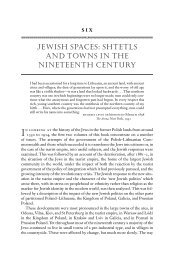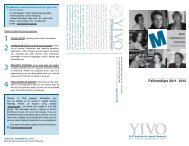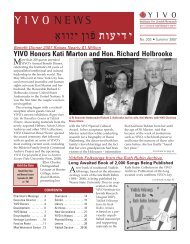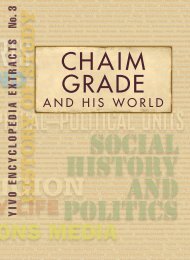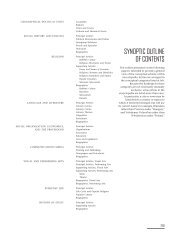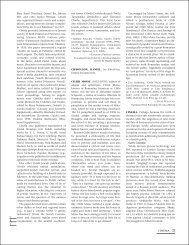Here - YIVO Institute for Jewish Research
Here - YIVO Institute for Jewish Research
Here - YIVO Institute for Jewish Research
Create successful ePaper yourself
Turn your PDF publications into a flip-book with our unique Google optimized e-Paper software.
over 30 films and over 30 visual installations includesdepictions of the Hungarian emigration to the UnitedStates at the beginning of the 20th century, the Germanoccupation in Holland and Greece, and the Spanish CivilWar. In his latest film – German Unity @ Balaton (2011),the political trans<strong>for</strong>mation in East Germany is portrayedthrough a juxtaposition of the vacation films of Germansspending their holidays at lake Balaton with the documentsof the GDR Ministry of Security which kept thesefamilies under surveillance.Common to all of Péter Forgács’ films is a nostalgicmood, particularly inherent in the slow-motion dynamicsof many of the takes, and the minimalist music of TiborSzemzö, whom the filmmaker works with on a regularbasis. One often gets the impression that the images arearranged <strong>for</strong> the music and not the other way around—afact confirmed by the artist himself. One of the rulesof this “patchwork game” is to “let the music carry theemotional story.” One easily <strong>for</strong>gets that the artwork,the story which gains a fictional dimension, is in realitya skillfully arranged sequence of documental shots. Theirreference to reality is all the more tangible because unlikeprofessional documentarians, their authors—amateurfilmmakers—filmed their own private world. WhatForgács attempts to do in his film practice is primarily toproduce new meanings from this extant archival footage.“It is always very intriguing <strong>for</strong> me,” he says, “when Iimagine how someone else might have constructed awholly different cinematographic meaning based on thesame material.”Forgács’ style has a distinctive character, not onlyesthetically, but also because of what his films make usrealize about the turbulent history of the 20th century,and there<strong>for</strong>e also about history in general. A fragmentfrom his film, El Perro Negro. Stories from the Spanish CivilWar (2005), which portrays Spain in the 1930s througha combination of films by the Salvans family and ErnestoNoriega, is highly representative of a large portion ofhis work. In one particular clip, a figure jumps into ariver, accompanied by a caption that reads “On July 18,1936, civil war broke out.” The juxtaposition of this keyhistorical fact with the image of an undisturbed momentof happiness and relaxation reminds us that private livesand events of national importance run parallel to oneanother, and that even the most momentous historicalcalamities do not immediately ruffle the course of privateexistence.Equally provocative are the playful antics in front of thecamera in the opening scene of El Perro Negro, or the



